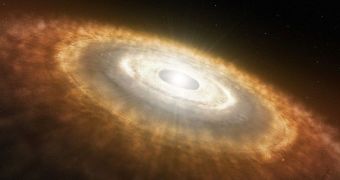Using data collected with the European Southern Observatory's Very Large Telescope (ESO VLT), researchers were recently able to discover two protoplanetary disks. Both of the structures caught the eyes of astronomers because they were orbiting their respective parent stars at about the same distance that Earth circles the Sun. This is of tremendous importance, because it could hint at the fact that, once planets form from the disks, they could inhabit the “habitable zones” around their parent stars.
The two fireballs found to be harboring the rocky and dusty rings are very young, which means that planets and other space rocks have yet to crystallize from the protoplanetary disks. The disks can be defined as remnants of the massive molecular clouds that fell on themselves and ignited, giving birth to the new star. The material that failed to get attracted during this event enters the orbit of the protostar and begins spinning. Eventually, the motion clumps dusty particles together, triggering the formation of planets, moons, asteroids, comets, meteorites, and so on.
The new observations were made possible through the use of the MIDI interferometer instrument, a tool on the VLT that allows astronomers to combine the light captured by the four, 8-meter telescopes making up the array. The result is an image that looks as if it was snapped using a 100-meter mirror, the team behind the new investigation reveals. The group also reveals that the two parent stars are similar in size to our Sun, with one of them showing a little hotter temperatures while the other is a bit cooler.
Details of the study results were first presented this week at the Royal Astronomical Society's (RAS) National Astronomy Meeting (NAM2010), held in Glasgow, Scotland. They represent the first instance when images of dusty discs so close in to their parent stars are made available.
“By probing regions of a similar scale to the Earth's orbit we have the potential to observe the dusty results of massive collisions in the final stages of rocky planet formation, and learn about the conditions Earth-like planets in other planetary systems may experience. The opportunities for directly testing our theories for how planets form and evolve have never been greater,” explains astronomer Rachel Smith.
The expert holds an appointment at the Newcastle-under-Lyme, England-based Keele University, and she was directly involved in the new investigations. Additional details of the study are also published in the latest issue of the esteemed scientific journal Astronomy and Astrophysics, Space reports.

 14 DAY TRIAL //
14 DAY TRIAL //